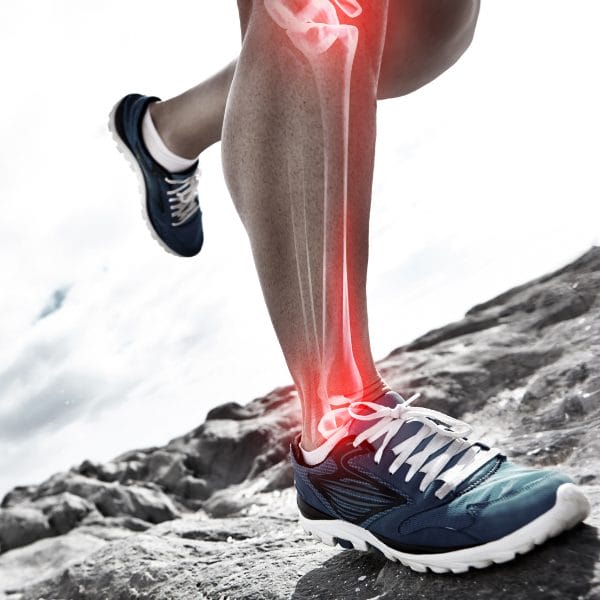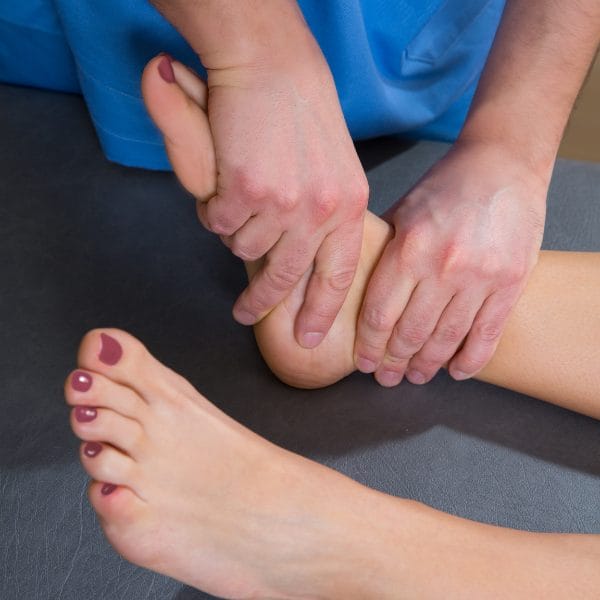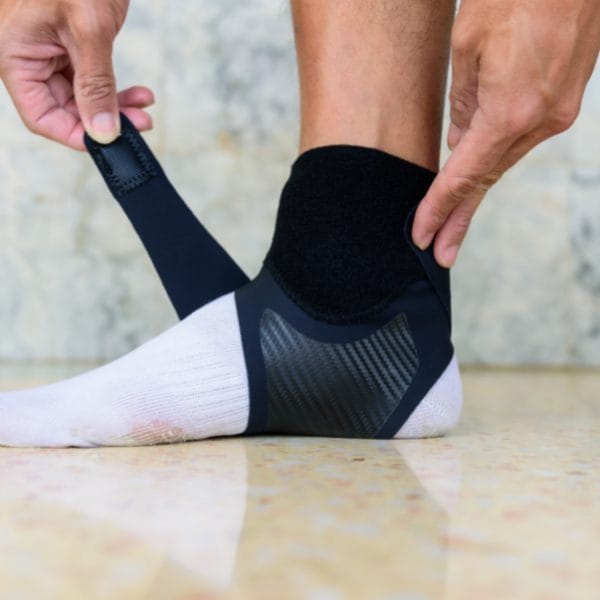Ankle Pain: what's going on?
One of the most common causes of ankle pain is simply overuse.
PostureGeek.com Tweet

If you’re like most people, you probably take your ankle for granted. You might not even give it a second thought until something goes wrong – and then it hurts like hell. So what’s going on when you struggle with ankle pain? What could be the cause of that nagging pain?
One of the most common causes of ankle pain is simply overuse. For example, suppose you’re constantly on your feet or participating in high-impact activities like running or basketball. In that case, you’re putting a lot of stress on your ankles. This can lead to inflammation and pain in the joints. If you think this might be the cause of your ankle pain, try giving your feet a break and see if the pain goes away.
The Ankle Joint

Your ankle joint is where your lower leg bones (tibia and fibula) meet your foot bones (talus, calcaneus, and navicular). This joint allows for a wide range of motion in your foot and ankle, including:
- Up-and-down movements (dorsiflexion and plantarflexion),
- In-and-out movements (eversion and inversion), and
- Rotational movements.
The ankle joint is held together by a thick web of ligaments, which are strong connective tissues that stabilize the joint. The bones of the ankle joint are also protected by a thin layer of cartilage, which helps to reduce friction and allows the bones to move smoothly against each other.
Causes of Ankle Pain
There are many possible causes of ankle pain. Therefore, it can be challenging to determine the exact cause without a thorough medical examination.
PostureGeek.com Tweet
There are many possible causes of ankle pain. Therefore, it can be challenging to determine the exact cause without a thorough medical examination. However, some of the more common causes include:
Ankle Sprain: A sprained ankle is a stretching or tearing of the ligaments, the tissues that connect bones to each other. The most common type of sprain is an inversion sprain, which occurs when the foot turns inward. This can stretch or tear the ligaments on the outside of the ankle.
Fractures: A fracture is a break in one or more of the bones in the ankle. The most common type of ankle fracture is a lateral malleolus fracture, which occurs when the bone on the outside of the ankle is broken.
Flat Feet: Flat feet, also known as pes planus, are when the foot does not have a normal arch. This can put extra stress on the ankle joint and lead to pain.
Arthritis: Arthritis is a common cause of ankle pain, particularly in older adults. Osteoarthritis, rheumatoid arthritis, and gout are all types of arthritis affecting the ankle joint.
Injury: Sprains and fractures are common injuries that can cause ankle pain. A sprain occurs when the ligaments that support the ankle are stretched or torn. A fracture occurs when one or more of the bones in the ankle is broken.
Tendinitis: Tendinitis is an inflammation of the tendons, the tissues that connect muscles to bones. Peroneal Tendinitis is a common type of tendinitis that can cause ankle pain.
Bursitis: Bursitis is an inflammation of the bursae, the small, fluid-filled sacs that cushion the bones, muscles, and tendons around a joint.
Ankle Impingement: An ankle impingement occurs when a bony growth at either the front or back of the ankle bone restricts a person’s normal range of motion. Pain may be felt in the front, rear, or even sides of the ankle.
- Anterior Ankle Impingement: Scar tissue or bone spurs, generally a result of an acute injury or continual stress on the ankle, are the most common causes.
- Posterior Ankle Impingement: Posterior Ankle Impingement is a problem that occurs when the bone or soft tissue structures in the back of the ankle are compressed during activities that require maximum ankle plantar flexion motion (toes pointing down).
Rare Causes of Ankle Pain
There are also some rarer causes of pain that may require medical attention. These include:
- Infection: Infections, such as cellulitis, osteomyelitis, and septic arthritis, can cause pain around the foot and ankle.
- Gout: Gout is a type of arthritis that occurs when uric acid crystals build up in the joints.
- Reactive arthritis: Reactive arthritis is a type of arthritis that occurs in response to an infection elsewhere in the body.
- Cancer: While rare, cancer can also cause ankle pain. Bone cancer, for example, may cause pain in the ankle.
Is the location of pain important?
The location of ankle pain can be important in determining the cause.
Lateral (outside) ankle
Pain on the outside of the ankle is often caused by overuse injuries such as peroneal tendonitis. These conditions are often seen in runners or other athletes who put repetitive stress on their ankles. Treatment for these conditions includes rest, ice, compression and elevation. In some cases, you may also need to wear a splint or brace to immobilize the ankle.
Medial (inside) ankle
Pain on the inside of the ankle is often caused by arthritis or an injury to ligaments or tendons. Treatment for these conditions includes rest, ice, compression and elevation. You may also need to wear a splint or brace to immobilize the ankle. If you’re still experiencing pain after trying these home remedies, it’s essential to see your doctor. They can determine the underlying cause.
Front of Ankle
There are many possible causes of front ankle pain, including Ankle Impingement or Tibilalis Tendon Tendonitis. In some cases, the cause of pain may be difficult to determine.
What are the symptoms of ankle pain?

Several different symptoms can be associated with ankle pain. These include:
Pain: The most common symptom of ankle pain is, not surprisingly, pain. This pain can range from mild to severe and can be constant or intermittent.
Swelling: Another common symptom of pain in the ankle is swelling. This may be due to an injury or arthritis.
Redness: If the ankle is red or inflamed, this may be a sign of infection.
Warmth: If the ankle feels warm to the touch, this may be a sign of inflammation.
Stiffness: Joint stiffness is often a symptom of arthritis.
Deformity: Bone cancers and other conditions can cause deformities in the ankle.
What are the risk factors for ankle pain?
Several different factors can increase your risk of developing pain. These include:
Age: The risk of developing ankle pain increases with age. This is due to the increased likelihood of developing arthritis and other conditions.
Inactivity: Inactive People are more likely to develop ankle pain than those who are active. Being active helps keep the joints healthy and strong.
Obesity: People who are obese are more likely to develop ankle pain than those who are not. Obesity often places extra stress on the joints.
Injury: People who have had a previous injury to the ankle are more likely to develop pain than those who have not.
Arthritis: People with arthritis are more likely to develop ankle pain than those without arthritis. Arthritis can damage joints and lead to pain.
Treatment for Ankle Pain

The treatment for ankle pain will vary depending on the underlying cause. However, some common treatments include:
RICE Protocol
Rest: Resting the ankle is often recommended for acute injuries, such as a sprain or fracture.
Ice: Applying ice to the ankle can help reduce inflammation and pain.
Compression: Wearing a compression bandage can help support the ankle and reduce swelling.
Elevation: Keeping the ankle elevated above the heart level can also help reduce swelling.
Medications
Nonsteroidal anti-inflammatory drugs (NSAIDs), such as ibuprofen, can help reduce inflammation and pain. Please consult with your doctor or health care provider to discuss the use of any medication.
Physical therapy and other allied health therapies
Your health care provider may recommend exercises to help strengthen the ankle and improve the range of motion.
Support and Stability Items
Wearing a supportive shoe or walking boot, or an ankle brace can help stabilize the ankle and reduce pain.
Injections
Your doctor may recommend steroid injections to help reduce inflammation.
Surgery
In some cases, surgery may be necessary to treat ankle pain. However, surgery is typically only recommended for severe injuries or conditions that do not respond to conservative treatment.
Diagnosis

Imaging tests
Imaging tests, such as X-rays, CT scans, and MRIs may be ordered to help diagnose the underlying cause of any changes to the ankle joint.
Differential Diagnosis
Your doctor or health care provider may perform a differential diagnosis to rule out other conditions causing the ankle pain. The differential diagnosis is a list of possible conditions that could be causing ankle pain. This includes conditions such as arthritis, gout, and infection.
Physical Examination
A physical exam is usually also performed. The doctor will check for swelling, tenderness, and deformity during the physical exam. They will also test a range of motion and muscle strength.
Blood Tests
Blood tests may also be ordered to look for signs of infection or arthritis.
Prevention of Ankle Pain

A few things can be done to help prevent ankle pain. These include:
Wearing Proper Footwear: Wearing shoes that fit well and provide support can help avoid ankle injuries.
Stretching: Stretching the muscles and tendons around the ankle can help reduce the risk of injury.
Strengthening: Exercising to strengthen the muscles around the ankle can also help reduce the risk of injury.
Wearing Proper Protective Gear: If participating in activities that carry a risk of an ankle injury, such as basketball or football, wearing appropriate protective foot and ankle wear can help prevent injuries.
FAQ's
Can the Achilles Tendon cause ankle joint pain?
Achilles tendonitis is an inflammation of your calf muscles caused by overuse. For example, suppose you’re a runner or play a sport like tennis or racquetball on the weekends. In that case, Achilles tendonitis might be blamed for your ankle discomfort. Because the Achilles tendon extends from your calf muscles down to your heel bone, this ailment may cause pain in your ankle and your calf.
How can I relieve pain in my foot and ankle?
If you’re experiencing ankle pain, the RICE method may help. This stands for Rest, Ice, Compression and Elevation. Resting your ankle and keeping it elevated above the level of your heart can help reduce swelling. Applying ice to your ankle can also help reduce both inflammation and pain. You can use a compression bandage or wrap to help support your ankle and reduce swelling. Over-the-counter pain medications such as ibuprofen may also help reduce both inflammation and pain. If you’re still experiencing pain after trying these home remedies, it’s essential to see your doctor. They can determine the underlying cause of your pain and provide further treatment options.
How long does ankle pain last?
The duration of pain can vary depending on the underlying cause. For example, Achilles tendonitis often goes away on its own after a few weeks of rest and home treatment. However, more severe conditions such as arthritis may require long-term treatment.
What does it mean when both ankles hurt?
There are many possible causes of ankle pain, so it’s essential to see your doctor or health care provider if you’re experiencing pain in both ankles. It’s possible that the pain is being caused by a condition that affects both ankles, such as arthritis. It’s also possible that the pain in one ankle is causing you to compensate by walking differently, which could lead to pain in the other ankle. Once your doctor or therapist has determined the cause of your pain, they can provide treatment options.
What can cause ankle pain without injury?
There are many possible causes of ankle pain, even without an injury. Some common causes include Achilles tendonitis, arthritis, gout and infection. In some cases, the cause of pain may be difficult to determine.
What does rheumatoid arthritis feel like in the ankles?
Rheumatoid arthritis is a form of arthritis that can cause pain, swelling and stiffness in the joints. This can often affect the ankles. Symptoms may include joint pain, swelling and stiffness. In some cases, the joints may feel warm to the touch.
How do you know if you have a fracture in your ankle?
A broken ankle can cause severe pain and swelling. Other symptoms may include bruising, difficulty walking and a deformity in the affected ankle. If you suspect you have a broken ankle, it’s important to see your doctor. They will be able to confirm the diagnosis and provide treatment options.
How do I know if my ankle pain is serious?
If you’re experiencing severe pain, swelling or deformity in your ankle, it’s essential to see your doctor right away. They will be able to determine the underlying cause of your pain and provide treatment options.
Finally
Ankle pain can be caused by various conditions that may require long-term treatment. Therefore, it’s essential to see your doctor if you’re experiencing ankle pain to determine the underlying cause and receive appropriate treatment.
If you’re experiencing severe pain, swelling or deformity in your ankle, it’s important to see your doctor right away. They will be able to determine the underlying cause of your pain and provide treatment options.
PLEASE NOTE
PostureGeek.com does not provide medical advice. This information is for educational purposes only and is not intended to be a substitute for professional medical attention. The information provided should not replace the advice and expertise of an accredited health care provider. Any inquiry into your care and any potential impact on your health and wellbeing should be directed to your health care provider. All information is for educational purposes only and is not intended to be a substitute for professional medical care or treatment.
